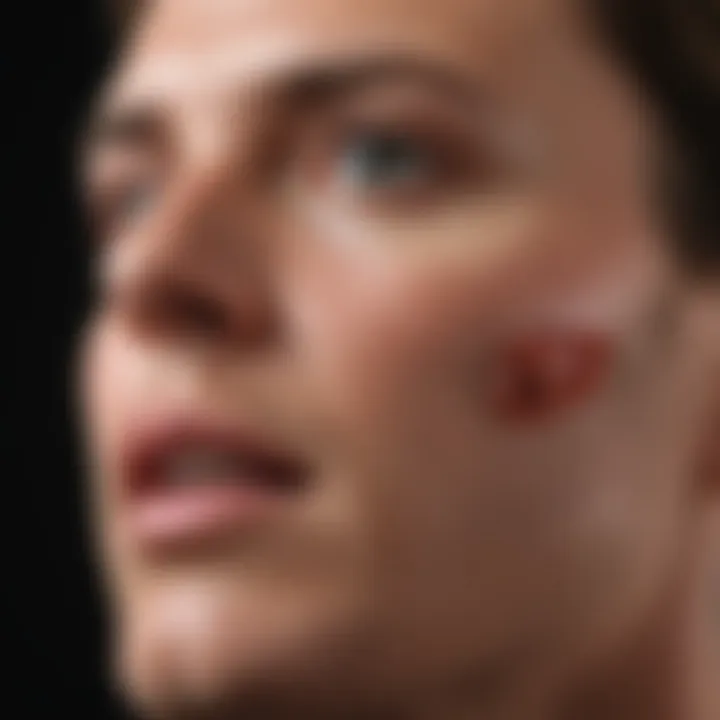Characteristics of Fasciculations: Nature and Implications


Intro
Fasciculations are spontaneous, involuntary contractions of muscle fibers, commonly recognized as muscle twitches. They often arise in resting muscles and may appear in various body parts, leading to a range of patient experiences. Understanding the nature of fasciculations is crucial, particularly for healthcare professionals and researchers engaged in neurology and muscle physiology. The pathophysiology of fasciculations gives insight into their potential significance as markers for neurological disorders.
Research Highlights
Overview of Key Findings
Research into fasciculations reveals a spectrum of causes and implications. These muscle contractions can be benign or symptomatic of underlying neurological issues, such as amyotrophic lateral sclerosis or multiple sclerosis. Examining patient reports can help in distinguishing whether the fasciculations are isolated events or part of a broader neuromuscular dysfunction.
Significance of the Research
Highlighting fasciculations focuses on their role as indicators of neurological health. By delineating the physiological mechanisms behind these contractions, practitioners can better understand a patient’s condition. This research can foster improved diagnostic accuracy and guide management strategies, impacting patient outcomes positively.
Clinical Features of Fasciculations
Fasciculations present in various patterns with distinct characteristics. Clinically, they can:
- Occur asymmetrically or symmetrically in different muscle groups.
- Accompany other symptoms such as muscle weakness or atrophy.
- Present during rest or after exertion at times.
Physiological Origins
Muscle twitches may originate from excited motor neurons. This excitation can be due to external stimuli, such as fatigue or stress, or internal factors, like electrolyte imbalances or neurological disorders. The careful assessment of these factors aids in identifying the root cause of fasciculations.
Diagnostic Approaches
The process for diagnosing fasciculations involves several steps:
- Patient history collection, including any noted triggers or associated symptoms.
- Physical examination focusing on muscle strength and coordination.
- Electromyography to assess muscle activity and motor neuron function.
By integrating these approaches, neuromuscular specialists can obtain a comprehensive understanding of the patient's condition.
Management Strategies
Managing fasciculations often entails addressing the underlying cause. Strategies may include:
- Medication for specific neurological conditions.
- Rehabilitation techniques to enhance muscle function.
- Lifestyle modifications, such as stress management and proper hydration.
Each patient requires a tailored approach for effective management, which can significantly improve their quality of life.
The multifaceted nature of fasciculations underscores their importance in clinical practice. Assessing these involuntary contractions can lead to early detection of significant neurological conditions.
Ending
In summary, addressing the characteristics of fasciculations is more than a matter of observation; it encompasses understanding their clinical implications. Through continued research, further insights may emerge, thereby enhancing diagnostic and treatment options available to healthcare professionals. This detailed exploration opens avenues for the effective management of affected patients, ultimately enriching public health knowledge.
Defining Fasciculations
Understanding fasciculations is essential for grasping their implications within the broader context of muscle and neurological health. Fasciculations are involuntary muscle contractions that may indicate various underlying health issues. By defining and differentiating these contractions, we can better assess their significance in the realm of diagnosis and treatment.
General Overview
Fasciculations are often characterized by small, local contractions of muscle fibers, visible as twitches beneath the skin. These contractions can occur in any skeletal muscle and are typically benign. The muscles might twitch involuntarily and intermittently, often unnoticed by the person affected unless they actively observe the area. While common, their occurrence can sometimes result from stress, fatigue, or excessive caffeine intake.
In a clinical context, fasciculations become significant as they can be a sign of more serious conditions. Neurological diseases, such as amyotrophic lateral sclerosis (ALS) or neuropathies, often manifest through these muscle twitches. Therefore, understanding the characteristics of fasciculations helps in identifying potential disorders early, leading to more effective management strategies.
Differentiating from Other Muscle Contractions
It is crucial to distinguish fasciculations from other types of muscle contractions. Muscle contractions can be categorized into multiple types, such as:


- Tonic contractions: These are sustained contractions often seen in postural muscles.
- Clonic contractions: These are rapid and relax quickly, like in certain spasms.
Fasciculations are unique in their irregular and spontaneous nature. Unlike tonic and clonic contractions, fasciculations are not typically associated with muscle exertion or voluntary movement. Understanding this distinction is vital for both clinicians and patients, as it influences diagnosis and management. This recognition allows for a more targeted approach when determining the underlying causes of the contractions.
Key Point: Recognizing fasciculations versus other muscle contractions aids in timely diagnosis, thus enhancing patient care.
In summary, defining fasciculations establishes a foundational understanding necessary for exploring their physiological mechanisms, clinical presentations, and implications.
Physiological Mechanisms
Understanding the physiological mechanisms underlying fasciculations is critical. This knowledge contributes to a deeper insight into how involuntary muscle contractions manifest and the potential significance they may hold in diagnostic contexts. Muscle twitching is commonly perceived as benign, yet, its origins may reveal details pertinent to neurological health. By examining aspects such as neuromuscular junction anatomy, the role of motor unit action potentials, and how these action potentials relate to fasciculations, one can form a more comprehensive perspective on this topic.
Neuromuscular Junction Anatomy
The neuromuscular junction (NMJ) serves as a crucial interface between the nervous system and muscular function. At this junction, the motor neuron communicates with the muscle fiber via the release of neurotransmitters. Acetylcholine is the primary neurotransmitter involved, binding to receptors on the muscle membrane and triggering contraction.
Key components of the NMJ include:
- Motor Neurons: These are responsible for transmitting impulses to the muscle.
- Synaptic Cleft: This gap between the neuron and muscle fiber houses neurotransmitters.
- Muscle Fiber Receptors: They detect the presence of acetylcholine and facilitate muscle contraction.
A disruption in any part of this complex system can lead to abnormal muscle activity, including fasciculations. Understanding the anatomy of the NMJ is essential for identifying the malfunctions that may occur.
Motor Unit Action Potential
Motor unit action potential (MUAP) refers to the electrical signal generated when a motor unit is activated. A motor unit comprises a motor neuron and the muscle fibers it innervates. The action potential travels down the axon of the motor neuron, influencing the muscle fibers to contract.
Features of MUAP include:
- Recruitment Pattern: Multiple motor units may activate to produce a stronger contraction.
- Frequency: The rate of stimulation can impact the strength and duration of the muscle contraction.
- Synchrony: Contractions can occur in a coordinated manner, impacting overall muscle performance.
Alterations in MUAP can manifest in various ways, stretching from involuntary muscle twitches to more serious neuromuscular disorders.
Role of Action Potentials in Fasciculations
Action potentials play a central role in the manifestation of fasciculations. Typically, these action potentials initiate a muscle contraction. However, when action potentials occur spontaneously or irregularly, they can lead to the characteristic muscle twitching seen in fasciculations.
Several factors may influence this phenomenon:
- Irritability of the Motor Neuron: Higher excitability can lead to increased spontaneous action potentials.
- Neuromuscular Transmission Issues: Malfunctions at the NMJ can instigate irregular firing patterns.
- Pathological Conditions: Diseases such as amyotrophic lateral sclerosis or radiculopathy may disrupt normal action potential propagation.
Fasciculations can indicate underlying neurological issues. Identifying their nature often requires understanding the contributing physiological mechanisms.
In sum, a detailed exploration of the physiological mechanisms reveals how fasciculations arise and the implications they hold for overall health. For students, researchers, educators, and professionals, this understanding is valuable, as it aids in the recognition of symptoms that warrant further investigation.
Clinical Presentation of Fasciculations
Understanding the clinical presentation of fasciculations is crucial for multiple reasons. First, the way these involuntary muscle contractions manifest can provide important clues to professionals evaluating patients. It also helps distinguish benign cases from those indicating serious neurological conditions. By examining the characteristics and context in which fasciculations occur, we gain insight not only into the underlying mechanisms but also into potential diagnostic approaches and management strategies. This section will elaborate on common manifestations of fasciculations and explore factors that influence their frequency and intensity.
Common Manifestations
Fasciculations can present themselves in various ways, depending on different factors. Commonly, they are noticeable as twitching or rippling movements, primarily in voluntary muscles. Often, they occur at rest and are not associated with any perceived force or effort. Some key characteristics include:
- Localized vs. Generalized: Fasciculations may occur in a specific area, such as an arm or leg, or may be widespread, affecting multiple regions.
- Duration: Episodes can be transient, lasting just a few seconds, or they can persist for extended periods.
- Visibility: In some cases, fasciculations may be barely perceptible, while in others, they are quite prominent, making them easily observable by others.
- Associated Symptoms: Patients may not experience any additional symptoms, but sometimes, there may be sensations of tingling or cramping.
The recognition of these variations helps in determining whether fasciculations are benign or if they warrant further investigation into underlying conditions.
Factors Influencing Frequency and Intensity
Several factors can influence how frequently and intensely fasciculations occur. Understanding these factors can inform clinical assessment and interventions. Some notable considerations include:
- Physiological State: Stress, fatigue, and dehydration can exacerbate fasciculations. For instance, during times of intense physical exertion, patients may report an increase in twitching.
- Nutritional Deficiencies: Low levels of critical nutrients, such as magnesium or vitamin D, can affect muscle function and lead to more pronounced fasciculations.
- Medications: Certain drugs or medications can trigger fasciculations as a side effect. Reviewing a patient’s medication history can be informative.
- Underlying Health Conditions: Conditions like amyotrophic lateral sclerosis or multiple sclerosis can both increase the prevalence and alter the nature of fasciculations.


Understanding these factors is essential for healthcare professionals as they approach diagnosis and management. Identifying underlying contributors helps tailor treatment strategies effectively.
Causes of Fasciculations
Understanding the causes of fasciculations is crucial to grasp their clinical significance and potential implications for diagnosis and management. Fasciculations can occur in a variety of contexts, indicating either benign conditions or more severe pathological states. Recognizing these distinctions helps healthcare professionals determine appropriate interventions and guides patients in understanding their symptoms.
Benign Fasciculations
Benign fasciculations are a common occurrence and typically present without any underlying health concern. These twitches usually arise in the absence of neurological disease and can affect any muscle in the body. Factors contributing to benign fasciculations may include:
- Stress: Increased anxiety or stress often triggers involuntary muscle contractions.
- Fatigue: Overexertion or muscle fatigue can lead to muscle twitches, particularly post-activity.
- Caffeine: Excessive intake of caffeine can stimulate muscle activity, resulting in fasciculations.
- Electrolyte Imbalance: Low levels of vital electrolytes like magnesium or potassium can cause muscle irritability and twitching.
Benign fasciculations, while often alarming to patients, usually resolve spontaneously and do not signify any serious health issues.
Neurological Disorders Linked to Fasciculations
In contrast to benign cases, fasciculations can also serve as a marker for neurological disorders. Conditions such as Amyotrophic Lateral Sclerosis (ALS), Multiple Sclerosis (MS), and spinal muscular atrophy may exhibit fasciculations as a significant symptom. Understanding these associations is vital for healthcare providers. Key disorders linked to fasciculations include:
- Amyotrophic Lateral Sclerosis: Characterized by progressive degeneration of motor neurons, leading to muscle weakness and atrophy, fasciculations often accompany this condition.
- Multiple Sclerosis: In MS, damage to nerve pathways can result in muscle spasms and fasciculations due to disrupted nerve signals.
- Spinal Muscular Atrophy: This genetic disorder leads to a progressive loss of motor neurons, manifesting in severe muscle weakness alongside fasciculations.
Identifying the underlying neurological disorder is essential for proper treatment and management, emphasizing the importance of a thorough clinical evaluation.
Systemic Conditions Affecting Muscle Contractions
Various systemic conditions can also lead to the occurrence of fasciculations. These conditions may not exclusively impact neuronal pathways but can adversely influence muscle functioning as well. Some conditions to consider include:
- Hypothyroidism: Low thyroid hormone levels can result in decreased muscle tone and lead to twitching due to reduced metabolic function.
- Chronic Kidney Disease: Impaired renal function may lead to electrolyte imbalances, contributing to muscle contractions.
- Medications: Certain drugs, including corticosteroids or diuretics, can precipitate fasciculations as a side effect by altering muscle excitability.
Recognizing potential systemic influences on muscle contractions helps identify patients at risk and aids in crafting personalized management strategies.
Overall, the causes of fasciculations are multifaceted, comprising both benign and pathological factors. Understanding these diverse origins is paramount for accurate diagnosis, effective management, and alleviating patient concerns.
Diagnostic Approaches
Understanding the diagnostic approaches for fasciculations is crucial since they can provide valuable insights into various underlying conditions. Accurate diagnosis not only aids in identifying the nature of fasciculations but also guides the treatment pathway. Various methods are used to evaluate these involuntary muscle twitching events. Each approach offers unique benefits, considerations, and potential limitations that healthcare professionals should be aware of when diagnosing patients.
Clinical History and Physical Examination
The foundation of diagnosing fasciculations begins with a comprehensive clinical history and physical examination. This initial step allows healthcare providers to gather essential information about the patient's symptoms, medical background, and any associated factors. For instance, asking about the onset, frequency, and duration of fasciculations can help establish patterns that may suggest specific causes.
During the physical examination, practitioners can assess muscle strength, tone, and reflexes, all of which can offer clues about the neurological status of the patient. Factors such as muscle atrophy or asymmetrical twitching may indicate an underlying condition. The clinical history and physical exam provide integral insights, often guiding further testing.
Electromyography (EMG) Studies
Electromyography is an instrumental diagnostic test in the assessment of fasciculations. EMG studies measure the electrical activity of muscle fibers, which can reveal crucial information regarding the function of motor units. During an EMG, tiny electrodes are placed on the muscle or inserted directly into it. This allows for real-time observation of muscle contractions and any abnormalities present.
The EMG findings in patients with fasciculations can help determine whether the twitching is benign or related to a more serious disorder. For example, a needle EMG may show increased spontaneous activity associated with fasciculations, indicating that the motor neurons are firing irregularly. These insights are essential for differentiating between different neuromuscular disorders and informing the treatment approach.
Additional Diagnostic Tests
Beyond the clinical history, physical examination, and EMG studies, additional diagnostic tests can play a vital role in the evaluation of fasciculations. Depending on the clinical context, these tests may include blood tests, imaging studies, and nerve conduction studies.
Blood tests, for example, can help rule out systemic conditions like electrolyte imbalances or thyroid disorders that might contribute to fasciculations. Imaging studies, such as MRI or CT scans, may provide insight into structural abnormalities within the central nervous system that could contribute to the symptoms observed.
Nerve conduction studies can assess the integrity of the peripheral nervous system and are often performed in conjunction with EMG. These tests measure how quickly impulses travel down the nerves, which can help identify any potential nerve damage or dysfunction.
In summary, a multifaceted approach to diagnosing fasciculations is essential for understanding their nature and implications. Each method contributes valuable information, allowing for a comprehensive evaluation that is crucial for proper patient management.
Management Strategies


Managing fasciculations is essential, particularly when they are linked to underlying health issues. The management strategies aim to alleviate symptoms, improve quality of life, and address any possible medical concerns. Understanding these strategies can provide clarity to healthcare providers and patients alike.
Therapeutic Interventions
Therapeutic interventions encompass various treatment approaches tailored to specific causes of fasciculations. These can include:
- Medications: Pharmacological treatments often help, particularly when fasciculations are symptomatic of broader neurological disorders. Medications such as anticonvulsants may be prescribed to manage muscle twitching.
- Physical Therapy: Engaging with a skilled physical therapist can assist in developing a personalized rehabilitation plan. Physical therapy may help strengthen surrounding muscles and reduce the frequency of fasciculations.
- Injection Therapies: In some cases, procedures like botulinum toxin injections can reduce severe muscle twitching for those suffering from conditions such as Amyotrophic Lateral Sclerosis (ALS).
Each intervention should be carefully evaluated considering the individual's clinical history and response to prior treatments. A detailed discussion between the patient and their healthcare provider is vital to find the most suitable options.
Lifestyle Adjustments and Patient Education
Lifestyle adjustments can significantly impact the frequency and severity of fasciculations. Educating patients about these adjustments is crucial to their overall management plan. Key lifestyle considerations can include:
- Dietary Modifications: Ensuring a balanced diet rich in essential nutrients helps maintain muscle health. Reducing caffeine and alcohol intake can also minimize stress on the nervous system.
- Stress Management: Stress often exacerbates fasciculations. Practices such as mindfulness, yoga, or regular exercise can improve mental well-being and lower the incidence of symptoms.
- Adequate Sleep: Quality rest is critical for muscle recovery and overall neurological function. Encouraging good sleep hygiene can prove beneficial.
Important Note: Patients should be informed that while lifestyle changes can significantly help, they should not replace professional medical advice or prescribed treatments.
Patient education also extends to understanding the nature of fasciculations, their possible implications, and the importance of adherence to recommended therapies. Providing resources such as literature and support groups can facilitate better patient outcomes.
Ultimately, combining therapeutic interventions with thoughtful lifestyle changes empowers individuals to take control of their health. This collaboration fosters a more proactive approach to managing fasciculations and improving their quality of life.
Research Directions
Research into fasciculations remains crucial, as it provides new insights into both physiological mechanisms and pathological implications. Understanding these muscle contractions can shed light on various neurological conditions that often manifest with symptoms such as twitching.
Exploring this area enables researchers to identify potential therapeutic targets and improve diagnostic accuracy for conditions like amyotrophic lateral sclerosis (ALS) and other neuromuscular disorders. The interplay of technology and neuroscience is pivotal in making advancements that can enhance patient care and understanding of the underlying mechanics of fasciculations.
Emerging Studies on Fasciculations
Recent studies in the field have started to unveil the complexities associated with fasciculations. Researchers are examining how these involuntary contractions might correlate with specific diseases. For example, studies have shown that increased frequency of fasciculations may signify greater impairment in certain neurological conditions. This connection prompts not only further inquiry into the mechanisms of fasciculation but also more comprehensive patient assessments.
Key areas of focus include:
- Genetic factors that influence the onset of fasciculations.
- Electrophysiological characteristics that distinguish benign from pathological fasciculations.
- Understanding how psychosocial factors and stress contribute to the muscle contractions.
An increasing number of clinical trials are testing therapies aimed at reducing fasciculations in patients. These studies could substantially impact treatment protocols, guiding clinicians in target-specific therapies that improve patient quality of life.
Technological Advances in Neuromuscular Research
Technological developments are revolutionizing neuromuscular research. Advances in imaging techniques and electromyography allow for more precise observation of fasciculations. Non-invasive methods are now better at tracking muscle electrical activity and observing nerve function in real-time, providing valuable data for both researchers and clinicians.
Some notable advancements include:
- High-density surface electromyography: This technique enhances spatial resolution in muscle activity monitoring, allowing detailed mapping of fasciculations across muscles.
- Magnetic resonance imaging (MRI): Improved MRI techniques are being utilized to visualize neuroanatomy associated with fasciculation, enhancing understanding of its mechanistic underpinnings.
- Machine Learning: AI algorithms are now being developed to analyze neuromuscular patterns, enabling researchers to draw insights that previous methodologies could not achieve.
With these innovations, researchers can not only enhance their understanding of the nature of fasciculations but also the implications these contractions may hold in broader neurological contexts. The ongoing examination of these elements will undoubtedly influence future treatment strategies and improve diagnostic accuracy.
Culmination
The conclusion of this article encapsulates the essence of understanding fasciculations and their relevance in the broader context of neuromuscular health. Fasciculations are not mere nuisances; they can signal various neurological conditions, making their study critical. Recognizing the patterns, causes, and implications of these involuntary muscle contractions allows clinicians to better diagnose and treat underlying issues.
Summarizing Key Insights
In summary, fasciculations possess several characteristics that can influence clinical practice. Key insights include:
- Nature of Fasciculations: Involuntary, spontaneous, and often benign muscle contractions.
- Neurological Indicators: They can signal potential neurological disorders or systemic conditions.
- Diagnostic Relevance: Understanding the physiology behind fasciculations aids in differential diagnosis and management.
- Management Strategies: Lifestyle modifications and therapeutic interventions can help alleviate symptoms.
Recognizing these insights provides a framework for both professional practice and further study of neuromuscular disorders.
Implications for Future Research
The future of research on fasciculations holds significant potential. Areas ripe for exploration include:
- Mechanistic Studies: Investigating the underlying cellular and molecular processes that lead to fasciculations.
- Relation to Disease Progression: Examining how fasciculations correlate with the progression of various neurological diseases.
- Impact of Technology: Utilizing advances in EMG technology could lead to more precise diagnoses and treatment plans.
- Broader Impacts: Examining the role of environmental factors and lifestyle choices in the frequency and severity of fasciculations.
Through focused research efforts in these areas, researchers can not only enhance the understanding of fasciculations but also contribute to improved patient outcomes in neuromuscular therapies.







